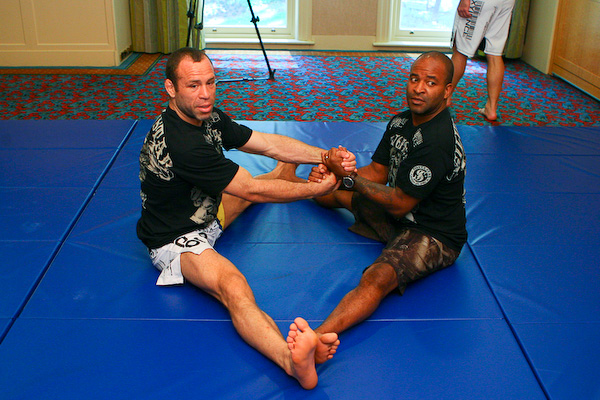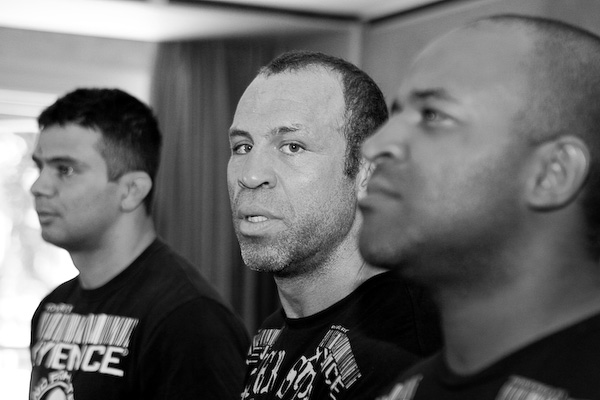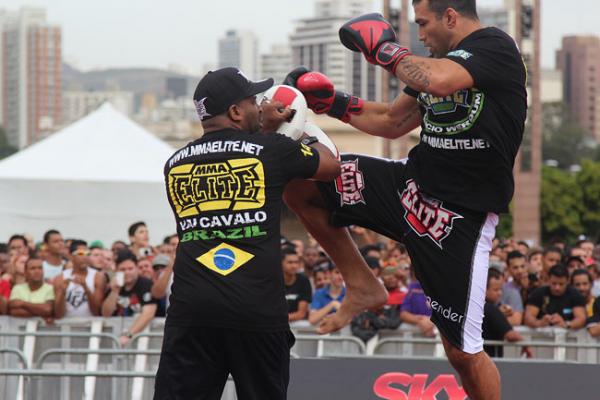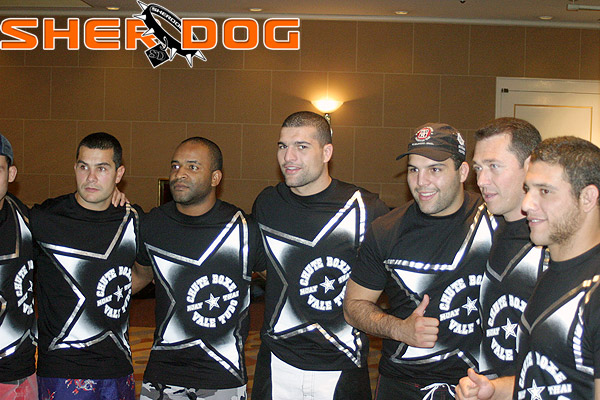One-on-One with Rafael Cordeiro

Rafael Cordeiro has trained some of MMA’s greatest fighters. |
Photo: Daniel Herbertson/Sherdog.com
HUNTINGTON BEACH, Calif. -- Keeping up with the evolution of a constantly changing sport is no easy task, but Kings MMA impresario Rafael Cordeiro has been on the cutting edge of mixed martial arts for more than 20 years. The former head coach of the legendary Chute Boxe team that spawned Wanderlei Silva, Mauricio Rua and Anderson Silva now trains some of the Ultimate Fighting Championship’s best as well, having taken Fabricio Werdum from a world-class grappler to a well-rounded interim heavyweight champion and catapulted Rafael dos Anjos from talented lightweight also-ran to serious contender.
The modern UFC differs drastically from Pride Fighting Championships back in the days of Chute Boxe’s dominance. The Octagon offers different spatial challenges than the ring and alters the nature of MMA wrestling, while the addition of elbows and subtraction of knees and kicks to grounded opponents shifts the possibilities for striking on the floor. Moreover, the context has changed. There is more emphasis today on preparation and training for specific opponents; camps are longer; weight cutting is more advanced and more important; and tournaments are essentially gone.
Advertisement
Throughout all of those fundamental shifts, the basics of Cordeiro’s approach have remained the same. He trains aggressive, hard-hitting, dangerous fighters with dominating skills at close range. In fact, Cordeiro is essentially the godfather of modern MMA clinch work. His fighters -- Wanderlei Silva, “Shogun” Rua and Anderson Silva foremost among them -- were among the first to demonstrate the effectiveness of clinch fighting, not just in the dirty-boxing sense popularized by Randy Couture and Team Quest but as a place to deliver vicious, fight-ending offense in the form of knees from the double-collar tie.
That clinch game is still visible in Cordeiro-trained fighters
today. Fabricio
Werdum mauled Roy Nelson at
close range; Jake
Ellenberger knocked out the iron-jawed Jake Shields
with a clinch knee during his time training under Cordeiro; and dos
Anjos is no slouch, either. In all of his fighters, the willingness
to move forward and finish the fight is clear, and his methods of
training seek to hone that aggression to the finest edge.
Despite his well-deserved reputation for training some of the most aggressive and violent fighters in the history of the sport, I observed Cordeiro himself to be a cheerful, encouraging presence in the gym. For all the stories about the brutality of Chute Boxe’s training sessions back in the Pride days and the hard sparring that still happens at Kings, this was a fairly relaxed session consisting of a few quick-paced striking drills and live MMA sparring on the ground.
Cordeiro constantly doled out positive reinforcement and praise, and at the end of the session, the experienced collection of fighters -- Werdum, Beneil Dariush, Nolan Ticman and Matt Horwich, among them -- gathered around to share information and techniques. Knowledge flowed freely, without distinction of rank or accomplishment in the sport.
The most striking thing I observed, however, came after the training finished. Dos Anjos, fresh off his victory over Nate Diaz, stopped by the gym. Holding him up as an example, Cordeiro gathered around everyone and talked explicitly about the importance of not just winning but doing so in impressive fashion. Be confident, be aggressive and finish fights, Cordeiro said, and the fans and the promotion will reward you for your efforts. His fighters listened attentively, the lesson clear.
No matter how much the sport changes over time, some things remain the same, and Cordeiro understands those facets of the game with great depth and clarity.
In this exclusive interview, Cordeiro discusses his beginnings, the rise of Chute Boxe, his move to Kings MMA, his approach to teaching, coaching and training and the methods behind that approach:
Sherdog.com: I was hoping we might start a little bit with your background and how you got into coaching in the first place. When did you start doing muay Thai?
Cordeiro: I started with muay Thai at 13 years old, and I’m 41 now. Before, I was training tae kwon do in Brazil and then muay Thai; I never stopped. I’m a three-time Brazilian champ, won muay Thai tournaments in Brazil, and I finished my career at 31-0.
Sherdog.com: And you had a bunch of vale tudo fights, as well, correct?
Cordeiro: Yes.
Sherdog.com: What led you to go from fighting in both muay Thai and vale tudo to coaching? Was it a plan you had or did something happen?
Cordeiro: Something happened, because I started with muay Thai. Muay Thai in Brazil, back in those days, didn’t have a lot of support from sponsors, and then one day, they started to invest a lot of money in MMA, so we changed things for MMA and started to train. Right after, I started to help my team -- my guys from muay Thai -- to develop their game in MMA, so I started to train jiu-jitsu with the gi. Soon after that, we had the opportunity to fight in the first MMA tournament in Brazil, and it was a great success for the guys from my gym. We beat four guys from another gym, and this made our team famous in our city [of Curitiba], and we never stopped. It was in 1993, our first MMA tournament, our first vale tudo tournament, and after that, we never stopped. After that, I was keeping on competing, and I stopped competing in 1999 to start teaching [full-time]. I was always teaching and competing all the time, doing both, and then one day, I felt I needed to help my fighters more instead of myself, so I started to teach more and more and more -- guys like Wanderlei, Mauricio “Shogun” [and] Murilo Rua. Everybody started to know [about them]. As soon as I started to just teach, I got more responsibilities at my gym, and I think I did the right thing, because after that, the guys became famous in Brazil and all over the world.
Sherdog.com: It is fascinating to me, watching over the years, that you are one of the very, very few coaches -- there are only a couple of guys -- who have managed to span the whole entirety of MMA as an organized sport and still have success teaching. There will be coaches who are successful for a few years, and then either they stop and go do something else or whatever, or their teaching just does not work anymore. That is not true with you. Over the years, as you have seen changes from a ring to a cage, no kicks on the ground, now you can use elbows, how have you adapted your style to keep up with these shifts?
Cordeiro: As soon as I moved here -- I moved seven years ago -- I changed all my training. When I was in Brazil, it was one thing, and as soon as I moved here, we changed everything because of the evolution of the sport. You need to learn new things every day; with these guys, I learn a lot from all my students. I developed my muay Thai and added wrestling conditioning and the pressure against the cage and then on the floor from top position, with the wrestler’s pressure over the fighters, so we learned a lot about that. We mixed our games. I developed my standup, and as soon as I learned this, I learned to mix everything, so we do specific things. So my muay Thai today I mix with grappling. I mix it on the floor, so it looks like muay Thai on the ground the way we do it here, with a lot of aggressiveness. We always try to find positions to hit [your opponent], cut with elbows; no more soccer kicks. I think we did the right thing, because I have a lot of people to support me and make my gym famous, and I developed my techniques today. Today I teach for a lot of guys; they come from jiu-jitsu, wrestling, muay Thai, and the way we teach here makes a difference inside the Octagon because I put more weapons in my fighters. I make my fighters really aggressive, not scared, no fear to throw things, so that everybody believes [in themselves] 100 percent. When they go, they go to kill or die. That makes a lot of difference.
Sherdog.com: You mentioned adapting things for MMA and changing your style. I noticed when you were teaching MMA grappling that you put a lot of emphasis on striking in transition. You were saying, “There’s space there, punch. Don’t wait, punch. If there’s space, always punch.” I thought that was really interesting, because it speaks to exactly what you are saying: always aggressive.
Cordeiro: Sometimes you can just roll on the floor, but you need to [actually] defeat your opponent. When you roll, you give opportunities for him to submit you, and you need to really beat him.
Sherdog.com: That’s really interesting. I noticed in all the training, not just on the ground but also standing, you put a lot of emphasis on how much time there was left. In conversations with other coaches, they have said that one of the big things that has to change when you go from a straight grappling situation to an MMA grappling situation is how much more time-sensitive it is, that you have to move fast because the ref will stand you up or because if it takes you two minutes to get to the floor, you only have three minutes to work. Is that something that you had always been thinking about or has your approach changed over the years?
Cordeiro: Always. Because I’m in the corner all the time, they know when I talk. Everything I talk here, I talk inside the Octagon, not just about techniques but about everything. Time is one thing, all the time I say it, so that they know what to do and how fast they need to work. Sometimes, he [the fighter] is in a bad situation, and I say “Two minutes,” and he knows he needs to change the situation. Everything I talk now, I talk inside the Octagon, so that my voice in their ears is familiar in all languages. So about techniques, about defense, counter, attack, how far he can go, about the time, so everything that happens there isn’t new. They already know, because they hear it all the time here. If you are comfortable, it is just one more day in training. I put everything we do here there on fight day.
Sherdog.com: I did notice that you were constantly encouraging and constantly talking as you were moving around in training, and it is interesting that there is a distinct in-fight purpose for that. At this point, you probably have more experience in the corner than any other coach in MMA at a high level. When you’re in the corner and you’re watching what is happening, are you focused more on big-picture things like staying away from the fence -- strategy, in other words -- or tactical things, like what is happening in an exchange and where there might be an opening to land a specific shot?
Cordeiro: I look at what my fighter is doing right and what he is doing wrong. I am never going to tell my fighter how tough his opponent is, so I’m going to talk about how good [my fighter] is. This is my goal with my fighters. So with Mark Hunt, I never said, “Fabricio, Mark Hunt has heavy hands, so please take care.” No. “Fabricio, you’re a good fighter, lift your hands, move your head, slip, roll, pay attention, action, reaction.” I am going to say, what is the quality of my fighter? I am never going to say how tough his opponent is. I talk about my fighter’s quality, make my fighters more confident. Everything you say to your fighter he’s going to try to do. All fighters trust their coach a lot. Everything you say he is going to absorb. If you say something to make him not so comfortable, when he starts the fight, he’s going to be afraid to do something because you say, “Take care, don’t do this because if you do, [the opponent] is going to hit you, put you on the floor.” So I talk to my fighters about confidence, just about how hard they train here in the gym, how good they are, and that makes a lot of difference. Encourage them, this is the deal.
Sherdog.com: Positive reinforcement.
Cordeiro: Positive. I don’t talk about opponents. I watch all the videos, and when they come in here, they do not need to worry about anything, because I do the training specifically for each fighter, so they know when I put a training for their fights they don’t have to worry. This is my job.
Follow Sherdog.com preview expert Patrick Wyman on Twitter.
Related Articles










